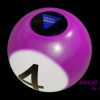Greetings!
Welcome to Scifi-Meshes.com! Click one of these buttons to join in on the fun.
Quick Links
AnimationComparing Notes, Animated
 David_cgc
David_cgc


 360
Posts: 18Member
360
Posts: 18Member

Around the time my image “Comparing Notes” was featured in the 2016 edition of the Ships of the Line calendar, I worked up an animated version, inspired by the “Active Duty” compilations of animated versions of various SotL images. The premise for the golden lighting of the original image was that it was captured at the moment the ships passed out of the shadow of Earth, and were briefly lit by dawn-colored sunlight passing through the atmosphere, the same reason the moon turns red during a lunar eclipse (and an effect that you can see happen on a real-life spacecraft in this video of the International Space Station), so I set up the animation to start in darkness, and then have a sudden dawn followed by bright white direct sunlight. I fiddled with it from time to time, incorporating the interiors I modeled for Dennis Bailey’s Enterprise and adding a cameo by the Endeavour’sbuddy-ship, the U.S.S. Sagittarius. However, I eventually put the animation aside, since my computer at the time would’ve taken forever to render it.
Time marched on, and Lightwave revamped its render engine, meaning older scenes would need to have their lighting and texturing adjusted to work in the new renderer. More recently, older versions of Lightwave on the Mac began having graphical glitches as newer versions of the OS came out, first having interface icons fail to render, and then drop-down menus, making the program nearly unusable. While I use the current version of Lightwave for my day-to-day, I did keep the last version that used the old render engine around to render my many, many old scenes and models when I didn’t have time to update them. But with this glitch, I remembered my old Comparing Notes animation, and decided it was now or never. A few months of rendering later (give or take a few breaks for video games and Stargate showcase renders), it came out.
The scene is pretty much exactly the way I left it five years ago, so it has some vintage quirks (for instance, it’s from before I started using linear workflow), but I did incorporate one modern touch. NASA released high-resolution HDR full-sky spherical map in 2020. I loaded the old scene into Lightwave 2020 so I could work with it (all I needed was the camera move, not the actual models and lights), and rendered the stars using that image map as a separate layer for later compositing. I also played with the exposure and grain layers in After Effects, creating the effect that the camera was compensating as the scene brightened. It worked really well. I’ve been disappointed when attempting to use sphere maps for stars in the past, but it looks like a 32k HDR is enough resolution to get the job done (the 64k version crashed Lightwave whenever I tried to load it), and can be adjusted to show individual stars against black, or the cloudy band of the Milky Way, depending on exposure. And there’s even a version with the foreground stars randomized so it can be used as a background in images set in distant star systems, avoiding the Battlestar Galactica problem of recognizable constellations showing up where they shouldn’t be, so this will be my solution for background stars in space images in the future.
Credits:
U.S.S. Endeavour and Drydock by Prologic9
U.S.S. Enterprise by Dennis Bailey
Shuttlecraft by Raul Mamoru
Travel Pod by Matthew Parker & Henry Gibbens
Tug by Jason Tinsley
Workbee by Unknown
U.S.S. Sagittarius by David Gian-Cursio
Music is “Remembering Data / The Enterprise” by Jerry Goldsmith from Star Trek: Nemesis
Tagged:
Additional credits
- Icons from Font-Awesome
- Additional icons by Mickael Bonfill
- Banner background from Toptal Subtle Patterns
© Scifi-Meshes.com 2001-2024

